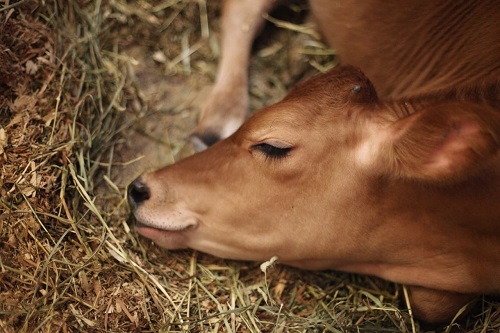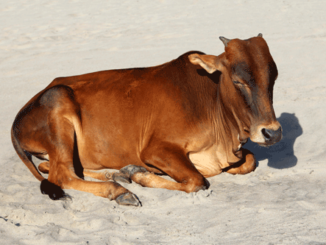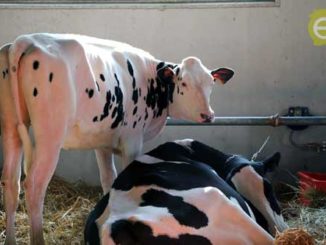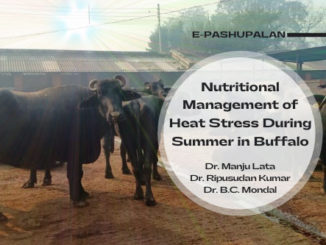Under normal circumstances, a bovine spends about 9-10 hours in standing position and 14-15 hours while resting on a comfortable floor. A completely healthy milking cow or buffalo can continuously remain in a decumbent position for 30 minutes to four hours. If she remains accumbent for longer periods or she doesn’t even make an attempt to rise, then, a serious problem could be guessed.

There are many reasons for prolonged recumbency in animals. These can be grouped into four categories.
- Metabolic causes including deficiencies of blood calcium, phosphorus, magnesium or potassium, fatty liver syndrome or rumenal acidosis etc.
- Toxaemia like in acute udder inflammation (E coli mastitis), acute metritis, pneumonia or peritonitis etc.
- Traumatic reasons like fractures in bones of legs/pelvis, luxation of hip joint, muscular injuries, rupture or tear in digestive or reproductive tract etc.
- Neurogenic insults like obturator nerve injuries during dystocia, sciatic nerve paralysis, black quarter, tetanus etc.
All the above listed causes have been described in detail in following paragraphs.
The most prevalent reason for prolonged recumbency in bovines is by far the sudden lack of sufficient amount of ionic calcium in blood circulation following calving. During pregnancy, the animal does not produce milk. The requirement for calcium is, thus, very limited during such periods. However, the demand for calcium skyrockets following parturition. Large quantities of calcium will be needed to synthesize colostrum and milk. This increased demand of calcium cannot be met by simply increasing calcium level in the diet of the animal. Animal tries its best to cope up the situation by drawing extra calcium from the bones. In situations where the calcium reserves (in bones) are already depleted or when the mechanisms for mobilizing bone calcium to blood pool fail to materialize, the blood levels of ionized calcium falls drastically below the critical limit. The animal makes an unsuccessful attempt to rise. She continues to remain recumbent for variable periods of time till the blood level of calcium is restored.
The calcium reserves in bony tissues of a particular heifer are sufficient to last for first two lactations. This is the reason why most of calcium related recumbencies are encountered in third or higher parities. The calcium reserves get depleted when the diet of the animal contains no source of calcium at all. Sometimes, calcium does exist in the diet but it doesn’t get absorbed because of its poor quality. Presence of chelating agents (like oxalates in overripe millet or Napier grass) in the diet may also lead to hypocalcaemic conditions. Feeding of extra calcium during last fortnight preceding parturition will lead to sluggish withdrawal of calcium from bones after calving, thus, becoming a precipitating cause of milk fever. Inclusion of excessive amounts of oil seed cakes or baking soda in the diet of animal in very late stages of pregnancy will also cause calcium deficiency after calving.
Animals suffering from milk fever can be effectively treated by administering calcium salts especially calcium borogluconate directly into the blood. On many occasions, recumbent animals do not respond to calcium salts. When the recumbent animal changes its position by crawling, it is often called a “Creeper Cow”. This condition is not caused by calcium deficiency; rather ‘phosphate’ deficiency is the main culprit. This condition can be successfully cured by injecting sodium acid phosphate into blood. It is important to note here that bovines need phosphate (PO4) not the elemental phosphorus (P) for various physiological functions of the body. The organic phosphorus preparations will be of no use for this ailment.
Most of the green fodders contain more than sufficient quantities of potassium. Animals seldom suffer from potassium deficiency when they consume good quantity of green fodders. Any diseased condition which causes prolonged anorexia will lead to potassium deficiency. The normal range of blood potassium in cattle is 3.6 – 5.4 mEq/L. Its critical level is 2.2 mEq/L. When the potassium level drops below critical value, the animal will exhibit a sustained recumbency. Animal will feel extreme muscular weakness owing to potassium deficiency. The condition can also be diagnosed with test therapy by feeding potassium acetate for a few weeks. The favourable response will prove the deficiency.
Each pregnant animal should receive magnesium oxide (10-15 g) for a fortnight prior to calving. Such animals will usually remain healthy throughout puerperal period. Failure to feed magnesium oxide powder, often, leads to its deficiency in blood after parturition. Magnesium deficiency may also cause calcium deficiency concurrently leading to recumbency. When the recumbent animal appears active, attentive and hyper aesthetic, it will most probably be concurrent deficiency of calcium and magnesium. Such animals will usually keep their necks extended forwardly. When the hypocalcaemic animal has normal magnesium levels, she will generally appear dull and depressed and will keep her head on abdomen by bending the neck.
High yielding animals will always remain in negative energy balance during initial weeks of lactation. The demand for energy to produce high quantity of milk always remains on higher side than the energy available from all sources of dietary origin. Liver plays an important role to supply energy for each activity of the body. This is the reason why the high yielding animals experience higher incidence of liver problems during late pregnancy and early post-parturient period. The most common ailment is fatty liver syndrome. This is mostly seen in pluriparous animals. The affected animals have high quantity of fats deposited in their liver cells. Performance of liver cells gets diminished significantly. Appetite of animal reduces drastically. She starts showing signs of progressive weakness ultimately leading to recumbency. The pregnant animal, therefore, must receive sufficient quantity of well balanced diet that can be digested easily. Sudden changes in the diet should always be avoided. Extra gruel (of wheat or maize origin) may be fed to animals approaching parturition. This will meliorate the energy reserves in the body prior to calving. Efforts should also be directed to keep the rumenal pH towards acidic side. Use of baking soda in the diet of the animal may be stopped altogether or it may be reduced at least. The acidic pH will aid in the better absorption of calcium and magnesium.
There are occasions when an animal gets an accidental access to excessive quantities of concentrate ration, grains or potatoes. Sometimes, people deliberately make their animals eat extravagantly the leftovers from a marriage function or some other kind of party. The animal, often, refuses to eat fodders thereafter. The animal recovers quickly if the right treatment is instituted immediately. The wrong treatment or any kind of delay in the treatment may leave the animal to become recumbent within two three days. This condition develops because of accumulation of copious amount of acids in the rumen. Initially, affected animal exhibits off-smelling diarrhoea. Grains may even be seen in the loose faeces in case of excessive intake of cereals. The animal is frequently seen grinding her teeth. She may also experience bloating because of loss of rumenal motility. Within few days the excessive amount of acids (especially lactic acid) from rumenal contents gets absorbed into blood circulation, thereby, reaching laminae present inside all the hoofs. These laminae become highly inflamed owing to exuberant lactic acid. The animal feels intense pain because of these inflamed laminae. She usually go down (become recumbent) to alleviate this pain.
During E. coli mastitis, the udder of the affected animal gets severely inflamed. The udder and/or teats become red coloured. The animal feels intense pain when touched with hands. E. coli toxins almost destroy the alveoli thereby stopping milk yield altogether. A part of blood plasma also appears into alveolar secretions making it sanguineous in nature. Use of right antibiotics at right time along with supportive therapy can treat the inflammation successfully. However, use of wrong antibiotics or delayed treatment can lead to severe toxaemia causing the animal to prostrate.
A few animals can develop severe metritis following delivery by unhygienic methods. The uterine discharge is often foetid smelling. The treatment is mostly unsuccessful. The whole course of things culminates into development of blood toxaemia. The animal becomes very weak within a few days. She even fails to keep herself in standing position. The recumbent animal has cold extremities. The animal appears highly depressed.
Drenching liquids to animals is a skill. The head of the animal must be kept parallel to the ground at the time of drenching. The tongue should always be free at this moment. If, somehow, liquid enters respiratory tract, it may cause severe pneumonia. The animal becomes initially cyanorectic, later on turning anorectic. The pneumonic episode ultimately culminates into recumbency.
Acute peritonitis can also become the cause of recumbency in bovines. Peritonitis causes toxemia, dehydration, cyanorexia, progressive weakness ultimately resulting in recumbency. Peritonitis is, often, the result of some other diseased condition like rupture in a part of digestive tract. The rupture can occur due to presence of sharp metallic objects like nails, wires, needles etc. Cancer or blockade of blood circulation to a part of the tract can also cause rupture. Any kind of rupture in uterus, liver, spleen or urinary bladder can also lead to peritonitis. Intestinal worms especially ascarids can also perforate the intestines. The ill-trained AI worker can also cause perforating wounds in uterus at the time of artificial insemination.
Animals usually become excited at the time of estrus. They show homosexual behaviour. In an attempt to mount others, the animals often get their hind legs injured. These injured animals prefer to lie down for most part of the day. In some instances, they exhaust themselves and are unable to stand up.
The slippery, moist and muddy floor sometimes proves unfortunate for animals. They fall down when they run. The hind legs get stretched out. The animal attempts to rise but fails all the time. There is most probable luxation of hip joints. The ligaments of these joints become injured. This is also one of the causes of recumbency. Sometimes, weak animals are able to lie down on slippy floors, but they get their legs injured while attempting to rise. Thereafter, they try to remain accumbent for longer periods.
When the heifers are bred at younger age, they usually experience difficult parturition (dystocia) because of disproportionate size of the foetus. This also happens when breeds of smaller body frame (Jersey breed) are inseminated with semen of bulls with heavy body frame (Holstein Friesian breed). When the foetus of comparatively larger size is extracted out with force, the hips or other body parts of the foetus usually squeezes against the obturator nerve of the dam. The nerve gets injured in the process. The affected animal makes unsuccessful attempts to rise thereafter.
During attacks by rhabdovirus or clostridia, the muscles become very weak. The affected animals fail to stand for longer periods and they usually go recumbent.
When more than required amount of local anaesthetic is administered epidurally, the animal remains prostrated for longer periods. The ruminants are very much sensitive to xylazine. When equivalent of equine doses of xylazine gets administered in bovines inadvertently, they usually go recumbent. Any kind of serious traumatic injury to vertebral column (like deliberate beating of animal with a stick or rod in the back) can also pose danger for the animal to remain in standing posture. Dislocation of vertebrae, development of abscess or cancerous growth in spinal cord can also make the animal prostrated for variable periods of time. All diseases causing anaemia can make the affected animal very weak if right treatment is not instituted at right time. Such diseases usually include those which are caused by blood protozoans/rickettsia like anaplasmosis, theileriosis, surra etc. The progressive weakness often makes the animals recumbent in later stages of the disease. When pregnant animal with uterine torsion is not relieved of torsion at right time, she often becomes recumbent owing to weakness, intense pain originating due to development of adhesions or toxaemia.
Sometimes, multiple factors are responsible for prolonged recumbency of the animal. The animal becomes anorectic because of a primary factor. Anorexia, then, leads to development of ketosis or milk fever. These latter diseases often mask the primary cause. Examination of surrounding area around a recumbent animal can easily tell whether the animal has made attempts to rise or not. During muscle rupture or breakage in bony tissues, the prostrated animal often looks active. During calcium deficiency, the animal continues to eat fodders and drink water. The depressive attitude indicates some serious underlying problem like toxaemia due to pneumonia or peritonitis. The latter often occurring because of rupture in digestive tract or uterus.
Thus, many factors are responsible for prolonged prostration of bovines. The correct diagnosis and, right and prompt treatment will make the affected animal productive again very soon.
|
The content of the articles are accurate and true to the best of the author’s knowledge. It is not meant to substitute for diagnosis, prognosis, treatment, prescription, or formal and individualized advice from a veterinary medical professional. Animals exhibiting signs and symptoms of distress should be seen by a veterinarian immediately. |








Be the first to comment